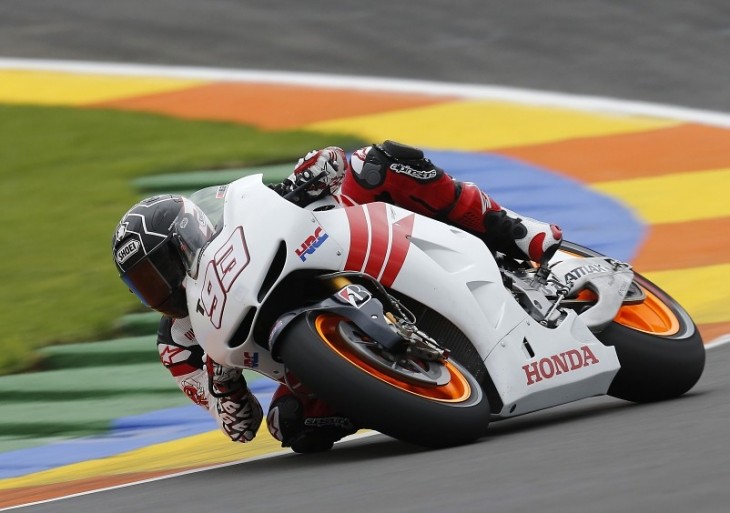Mark Marquez had a steep learning curve at the Valencia test earlier this week. First time on a MotoGP bike. First time with 250 hp (his Moto2 bike put out roughly 125). First time using carbon brakes. First time on MotoGP Bridgestone racing tires.
Despite this, and the dodgy Valencia weather, Marquez managed 27 laps. More impressively, with less than an hour of track time, he recorded a best lap roughly 1 second slower than the fastest lap of the test (by Honda teammate Dani Pedrosa), and just 3/10ths of a second off the fastest lap recorded in the Valencia MotoGP race last weekend (also by Pedrosa).
The veterans of the MotoGP class know that Marquez will be fast from Day 1. Already, some of the riders, including Valentino Rossi (now on a Yamaha) are claiming that Marquez rides too aggressively, i.e., he is dangerous. Marquez does take big risks, but the 2012 Moto2 champion expects big rewards in return, and he usually gets them.







Marquez is gonna be awesome. The only thing that will stop him from a championship is himself. Hopefully he will mature quickly and learn the value of not crashing, as Lorenzo has.
250hp/liter, MotoGP, normally aspirated 4-stroke. Wow.
If anyone knows: what is the octane rating of MotoGP racing fuel, if possible, stated in the same unit as so-called 91 octane domestic pump fuel, AKA “Premium?”
I just looked that up, and if what I saw was correct, then it is unleaded 100 octane.
Due to the restrictions on engine allotment in MotoGP (6 per season), these engines are probably making far less horsepower than they could, which in turn means they are in a lower state of tune than they could be in. If I was going to detune an engine, compression and RPM would be two places I’d look.
They’re still doing 200+mph. There’s too much power as it is. Do like Hefner says and bring hp to easily attainable levels and much of the expense goes away (engine development, electronics packages) and MotoGP rises again.
The flip side of the coin is that he may aggressively ride himself into the ground over an actual race distance.
I’m curious to see what happens.
Way off topic, but…
Why is it that no manufacturer can make a sportbike fairing like this? Simple a clean shape without unnecessary creases/angles/facets/layers? Just add a headlight or 2 and call it done? Do they assume that the marketplace would just consider that boring and plain?
kind of close to a 91-93 fzr 1000. That was a good bike.
now I googled one, and not so much. I still loved that old bike.
My guess is that the needs of a race bike, at race bike speeds, are different than that of a street bike. Looks are one thing but things like rider comfort are another. Heat management for the street rider caught in daily traffic might be one as well as seat padding. Ease of maintenance could be another? While race bikes are concerned with aerodynamics and presenting the least frontal area to the wind. While aesthetically the street rider might like extra farkles or some the minimalism approach. Can’t please them all!
All good points. Guess I’m just a minimalist.
There’s no comfort or heat management or maintenance or any other rational reason for that overstyled origami look. And having low drag is good for the street too. The fact is that it’s just marketing. Like women’s clothes. If they didn’t change the style they couldn’t sell as many bikes because some people are influence by the ‘new look’. Eventually they’ll cycle back around to more rational streamlining.
If it is just marketing, as you say, then it might mean the majority of prospective buyers want more than the minimalist approach. You may find it hard then to find a bike to satisfy your likes?
Three reasons:
1) Cost
2) Maintenance ease (seems MotoGP mechanics are a bit more skillful than the average bike shop mechanic)
3) Racing is not the same as riding on public streets.
Progression (good or bad). If street bikes followed the simpler shapes of GP bikes then designs would stagnate in the eyes of consumers. Lots of times shapes/designs change simply to be “new”. GP bikes are designed to generate wins, Street bikes are designed to generate sales.
Honda already did such a clean design — in the 90s. Here’s a pic of the CBR600F3:
http://image.motorcyclistonline.com/f/flashback/8564468++w760+ar1/122_9705_02z+1997_honda_cbr600f3+front_lean_view.jpg
It sold pretty well from what I recall. But I think the market wanted something more extreme looking.
Rossi is not accepting his decline gracefully. Marquez is just one more up and comer (very talented though) that is probably going to finish ahead of Rossi.
The new Marco Simoncelli in the class. Talented. Aggressive. Aggression pays off with near pole positions in MotoGP. He is used to going fast and he has experience with less help from electronics. So I think he will do fine and be another man to watch. Could be great with Lorenzo, Pedrosa, Rossi and Marquez all racing for the top. And don’t count out Bradl and Bautista either. Also let’s see if Ducati pulls a rabbit out of a hat.
What’s interesting is that he’s being called over aggressive and dangerous but in my eyes it is much harder as a rider to win in Moto 2 than Moto GP. In Moto GP, if you don’t have the best bike, you will never have a chance. In Moto 2, many have as good a bike as you. This kid showed he was the best race distance manager in a group of very good racers. How can one be over aggressive and dangerous yet still win a title in such a close class?
That said, he’ll probably crash a bit early on. Electronics aren’t needed with 125hp on today’s tires. They have to be perfect on one of these monsters.